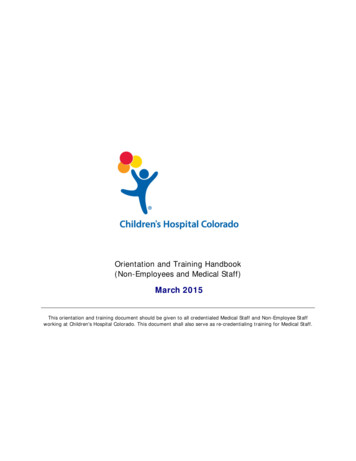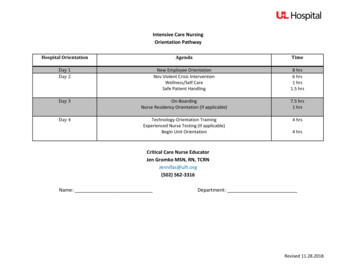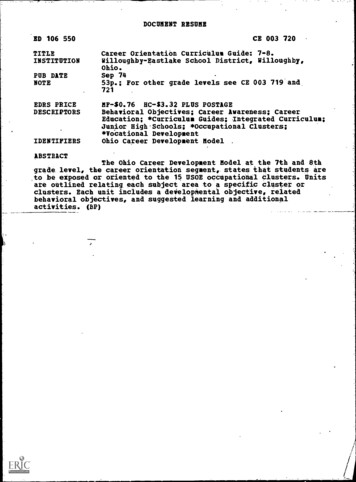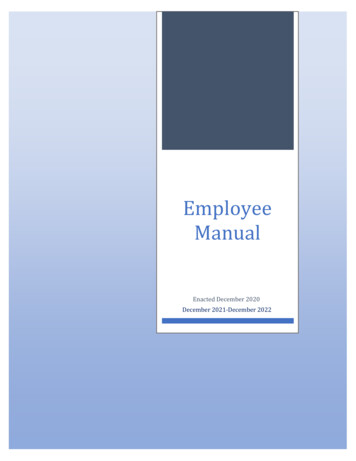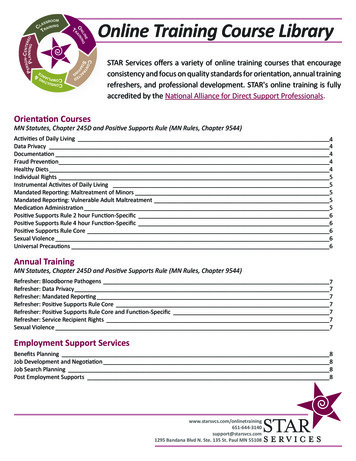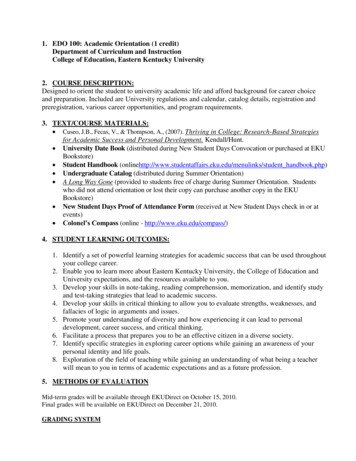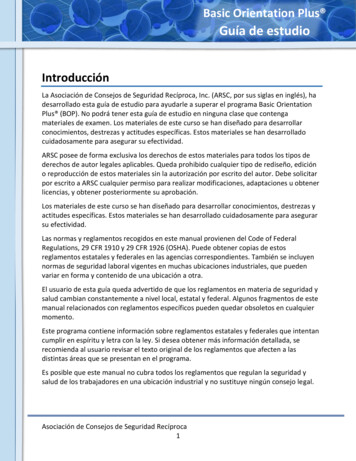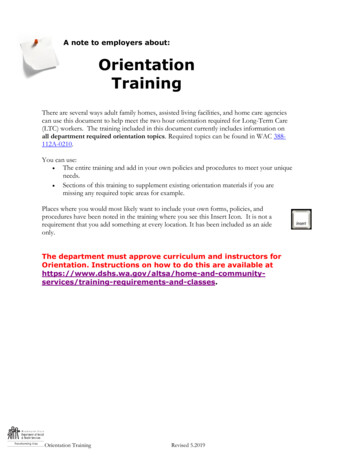
Transcription
A note to employers about:OrientationTrainingThere are several ways adult family homes, assisted living facilities, and home care agenciescan use this document to help meet the two hour orientation required for Long-Term Care(LTC) workers. The training included in this document currently includes information onall department required orientation topics. Required topics can be found in WAC 388112A-0210.You can use: The entire training and add in your own policies and procedures to meet your uniqueneeds. Sections of this training to supplement existing orientation materials if you aremissing any required topic areas for example.Places where you would most likely want to include your own forms, policies, andprocedures have been noted in the training where you see this Insert Icon. It is not arequirement that you add something at every location. It has been included as an aideonly.The department must approve curriculum and instructors forOrientation. Instructions on how to do this are available tion TrainingRevised 5.2019
Orientation TrainingIntroduction . 2Clients and Where They Live . 2Client Rights . 3Care Settings. 4Basic Job Responsibilities of a LTC worker . 5Understanding Your Job Duties . 5Getting the Information You Need . 6Establish a Routine . 7Ask Again . 7Good Communication . 7First impressions . 7Listen . 8Body Language . 8Talking on the phone at work .10Emergency Communication .10Communicating with care team members .10Documentation and Reporting . 10Observe .10Documenting .11Reporting .11Your role as a mandated reporter . 12Reporting abuse to DSHS .13In Conclusion . 15Orientation TrainingRevised 5.2019Page 1
OrientationIntroductionYou are taking this orientation training because you have recently beenhired by an adult family home (AFH), assisted living facility (ALF), or ahome care agency (HCA) as a long term care (LTC) worker.This orientation training gives you an overview of what you need to knowand do in your new job.Your role as a LTC worker is to provide quality care andsupport services to the people (clients) who live where youwork. These services are essential to the health, continuedindependence, and well-being of the clients in your care. Toprovide quality care, you must: Understand your role as a LTC worker. Complete all of your assigned tasks to the best of yourability each day. Respect client choices in how and when they would likethese tasks done. Keep clients safe. Learn and follow the policies and procedures of youremployer.ClientsA person requiring care is referredto by many different names.Examples you may hear includeclient, resident, consumer, orparticipant.In this orientation, we have usedclient to represent any of these.As you go through the training, this icon pointsout the key points.Clients and Where They LiveWhen clients need help with care for an extended period of time, it is referred to aslong term care.A client may be: Elderly and frail. Have a disease or condition making it hard or impossible to do certain taskswithout help. Have fallen or had another type of accident. Have a developmental disability.A client’s care teamYou are not alone in providing care and support to a client. There are many others who maybe part of a client’s care team.Care team members can include the client’s health care provider(s), family and friends, aguardian, other LTC workers, nurses or other skilled professionals, and/or a case manageror social worker from Home and Community Services (HCS) or an Area Agency on Aging(AAA).Orientation TrainingRevised 5.2019Page 2
Client RightsA client receiving care has certain rights protected by federal and state laws. It is a part ofyour job to understand and protect a client’s rights. The state law regarding client rights canbe found in RCW 70.129 and in Washington Administrative Code (WAC) 388-106-1300.You must: Treat clients with respect. Support a client’s choices and independence. Protect a client’s privacy and confidential information. Keep client’s safe.Below are some of the client rights protected by law in our state.Choice & FreedomClients have the right to: Take an active role in making or changing their care plan. Refuse care, medications, or treatment. Choose their activities, schedules (including meal timesand when care is given), health care, clothing, andhairstyle. Join in social, religious, and community activities. Manage his or her finances. Be free from chemical or physical restraints. Express a complaint or concern without fear ofretaliation. Be with people both inside and outside of their residenceincluding family, friends, his or her doctor and anOmbudsman (if in an AFH or ALF).A clientneeds and has the right to privacy When performing personal care:o Screen or cover a client.o Make sure doors andwindow curtains are closed.Only share medical, financial orother personal informationabout a client with appropriatecare team members.Give the client privacy forphone calls and visits.Let a client open mail in private.Respect privacy.Confidentiality and PrivacyClients have the right to: Have all medical, financial, and personal matters keptprivate. Have privacy in his or her own personal space and duringpersonal care.Health Insurance Portability and Accountability Act(HIPAA)HIPAA is a federal law that adds additional requirements for the use and disclosure of healthinformation.A major goal of HIPAA is to make sure a person’s health information is properly protectedwhile still allowing the flow of health information needed to provide high quality health care.Orientation TrainingRevised 5.2019Page 3
Your employer will review with you what you need to know to follow the HIPAAregulations as it applies to your job.Your role in protecting client rightsKnowing that a client has rights and what they are is only one step.Protecting these rights each time you are working with a client is part ofyour daily responsibility. Protecting client rights means you do thefollowing things every time you interact with a client: Treat clients with respect. Support a client’s choices and independence. Protect a client’s privacy and confidential information. Keep client’s safe.As you start your new job, it may seem easy to commit to always protecting a client’s rights.There will be days when it will be more difficult to do. You may be tired, understaffed,behind in your schedule, or frustrated by a client’s choice.Start from the beginning of your job to always ask about and honor a client’s choices. Thiswill help make it second nature during the more difficult days.Ask about and honor a client’s choices.Care SettingsBelow are the care settings that hire LTC workers.In-home careMost adults who need care get services and support to remain at home. One of the servicescan be hiring a LTC worker to help with care. Additional services and supports that may beoffered depending on that client’s care needs include nursing or other professional healthcare, community resources such as Meals on Wheels, hospice or respite care or homemodifications and assistive devices to help with independence.LTC workers working in a client’s home are either hired directly by the person needing careor through a home care agency.Residential careResidential care is another option for a client who needs help withcare. Adult family homes (AFHs) and assisted living facilities(ALFs) are two examples of residential care.Both AFHs/ALFs provide a room, meals, laundry, supervision, andhelp with care. In addition, some AFHs/ALFs provide occasionalnursing care and/or specialized care for people with mental healthissues, developmental disabilities, or dementia.AFHs are regular neighborhood homes that can provide care foranywhere between two to six clients. ALFs are large homes/facilities in the community that have seven or more clients.Orientation TrainingRevised 5.2019Page 4
AFHs and ALFs are licensed by the state. Regulations set by the state help ensureconsistent, quality care and services for all clients living in AFHs or ALFs. These regulationscan be found in WAC 388-76 for AFHs and WAC 388-78a for ALFs.Each home, facility, or agency has its own unique business philosophy and goals.Understanding your employer’s vision helps you get a better feel for your job and what willbe expected of you.Basic Job Responsibilities of a LTC workerFor the health and safety of a client,Below are some of the basic job responsibilities you will havecomplete all of the tasks assigned toas a LTC worker.you. Understand a client’s care needs and perform yourassigned tasks correctly and efficiently as documented inthe client’s care plan or negotiated service agreement. Know how and when a client prefers to have these tasks completed. Respect and followthe client’s choices. Observe the client for change(s) in health and well-being. Document and report any changes you see using the policies and procedures outlined inthis orientation. Respond to emergencies appropriately. Come to work on time, call your supervisor if you can’t make a shift, and dressappropriately. If you do not understand what it means to dress appropriately, ask yoursupervisor. Complete and keep accurate time sheets. Give two weeks written notice if you will be quitting your job.Job performanceHow well you do your job impacts a client’s life every day. Do your job well, and clientscontinue to live with dignity and independence. Do your job poorly and you risk causingphysical harm, distress, anxiety, and/or embarrassment to the clients you are being paid toprovide care and support.Do your best and take pride in your work. When you are at work, focus on your job. Learnhow to do your assigned tasks correctly and efficiently. Know what to do and what to avoid.Be honest, clear, and professional in your dealings with clients and other care team members.In addition, your employer has other expectations of you as a worker.Start your job with a solid understanding of what is expected of you.Understanding Your Job DutiesYou need to understand how and when to do each of your assignedtasks. You will get this information from the client’s care plan, other careteam members, and most importantly the client.Orientation TrainingRevised 5.2019Page 5
Care PlansEach client has a written care plan. A care plan is a document developed after a thoroughassessment (evaluation) was completed for that client.The assessment results in a clear understanding of what services and support the client needsand how and when he or she would like these services completed. These tasks and clientpreferences are documented in the care plan.A written care plan helps make sure the client receives consistent, quality care that meets hisor her needs. A client’s care plan changes as his or her care needs change.In an assisted living facility or adult family home, the care plan you will see is called thenegotiated service agreement or plan.What part of the client’s care plan you will see depends on where you work. Some LTCworkers will have access and read the entire care plan. Others will get a task list. If you areallowed, read through the care plan for each of the clients you are assigned to.You are always responsible for following the client’s care plan.The information in the care plan is confidential and sensitive. Respect the client’s need andright to have everything you read or hear kept private. Your professionalism goes a long wayin reducing a client’s uneasiness or embarrassment having such personal informationavailable to others.Getting the Information You NeedRespect a client’s preferences by making sure you get theinformation you need to honor them. You and the client need to: Know what you are expected to do. Understand the limits of your work. Feel like part of the same team. Avoid misunderstandings later by discussing the care taskscarefully when you first begin.Even with information from a care plan and other care teammembers, you still need to talk directly with a client and ask themabout his or her preferences.Asking good questions is an art. The way you ask questions of aclient gets you more of the information you need.Ask questions specific to the task.For example: “Do you prefer a bath or shower this morning?”Talk about the care plan or tasklist Be patient if a client finds talkingabout these issues difficult.A client may not be used totalking about such personalmatters.A client may find it hard toadmit that he or she needs help.It may be hard to explain aroutine he or she has had foryears.Respect and understand a client’schoices of how and when careservices are to be provided.Ask questions that are open-ended rather than questions that canbe answered “yes” or “no”.For example, asking: “What would you like for breakfast?”will get you better information than asking “Do you wantbreakfast now?”Orientation TrainingRevised 5.2019Page 6
Ask questions that start with what, when, where, why, andhow.For example, the care plan says you are to help with bathing.Ask questions like: “How hot do you like your bath water?”“What type of soap works well for you?”Asking good questions helps you get theinformation you need to do your job correctly.Establish a RoutineWhen you begin a new assignment, agree with a client on aroutine and then stick with it.A routine (or schedule) helps you to finish all your tasks. Aroutine means you and a client will know what to expect eachshift.Routines help you and a client.Ask AgainAsking Again Helps YouAfter working for a client for awhile, it is a good practice totalk with him or her again about tasks in the care plan. Isthere anything he or she would like to be done differently?By asking again, you can make sure you understand a client’sroutine and keep doing the tasks the way that works best forhim or her.Good CommunicationGood communication means more than talking to a client.Communicating well helps you provide quality care andmakes your job easier. Good communication means: Watching the client’s body language carefully to see whathis or her actions and gestures may be telling you. Listening carefully to any comments from the client. Make sure you understand aclient’s routine. Assist with tasks in the way thatworks best for a client. Learn more about a client’spreferences. Get feedback on how you aredoing.Ask Again to Know You HaveDone Your Job WellGood communication helps: Get you the information you need to do your job.Things go smoothly with a client and other care teammembers.Keep things calmer in stressful situations.Others view you as a professional.First impressionsYou only have a few seconds to make a good first impressionon clients, and the client’s family members, friends orOrientation TrainingRevised 5.2019Page 7
guardian. First impressions are based on your: Appearance. Body language. Behavior. Clothing.When meeting a client or his or her family, friends orguardian for the first time, pay attention to the followingareas.Meeting a client for the first time Review the client’s care plan before youmeet if possible. Does the client have anycommunication challenges such asdifficulty hearing or speaking? Plan aheadon how best to work with any challenges. Introduce yourself and explain why youare there. Ask the client what name he or she wouldprefer you use.You never get a second chance to make agood first impression Stop what you are doing and give the other personyour full attention. A warm and genuine smile makes you and the otherperson more comfortable and at ease. Stand tall, make eye contact, turn your body towardsthe person and greet with a firm handshake (ifappropriate for the other person’s culture). Introduce yourself and what you do. For example, “Goodmorning. My name is Sandy Cove and I am one of yourfather’s caregivers.” Use the person’s name several times in the conversation. This willshow you paid attention from the start.ListenAnother part of good communication is to listen! Good listening: Helps build trust with a client. Encourages honest sharing of thoughts and feelings. Makes sure you accurately hear what the other personsays.Good listening also gives a client time to find the right words. Encourage the client to continue by saying “I see,” “Tellme more,” “Um-hmm,” or by nodding your head. Ask questions and get more information when you areunclear. Do not jump in with your ideas or advice - wait untilyou’re asked. Be willing to listen to things a client needs to say don’tavoid a subject because you’re not comfortable with it.Good listening takes effort Give a client 100% of yourattention. Don’t try to listen while doingsomething else. Face a client and lean forwardslightly. This gives good eyecontact and shows interest.Good listening means.focus on a clientwhile listening.Body LanguageYour actions, how you hold your body, and your facialexpressions are all nonverbal communication - or bodylanguage.Orientation TrainingRevised 5.2019Page 8
Be aware of what your body language is telling a client. A cheerful expression and pleasant tone of voice show a positive attitude. Standing still and making direct eye contact shows you are paying attention. Good posture with arms relaxed shows you are approachable and confident. Always make sure your body language matches what youare saying with your words.Nonverbal communication is powerful.A client’s body languageA client’s body language may tell you more about how he or shefeels than what he or she says. Watch for non-verbal signs thathelp you better understand what is happening with a client.For example, here are some non-verbal signs of a client being inpain: A tight or tense body. Rocking back and forth. Constantly touching a place on his or her body that is in pain. A facial grimace or troubled eyes.By being observant of these non-verbal signs of pain, you can: Silence allows time forlistening and bringspeople together If a client is sad or worried, justlistening helps. Silence gives a person time tothink and to choose words. Silence gives a person time tocontrol anger or other strongemotions.Give people time to think and feel.Talk to a client about things you can do to make him or hermore comfortable.Be more careful when performing personal care tasks.Stay alert to the possibility of a growing problem.Watch for words and body language that do not match. In most cases, the body will tell you what isreally happening.For example, if a client says “I’m fine” but her body language tells you she is in pain, the chances areshe is not “fine” but is unable or uncomfortable talking about what she is feeling.Business CommunicationThere are times when you need to talk with your supervisor or other managers when you haveconcerns, questions, problems with a co-worker, or your schedule, etc. It is your responsibility to actprofessionally and resolve issues before things gets out of hand.Don't delay or hide problems: Give your supervisor time to help or plan for what is needed.Be positive. A positive attitude helps everyone who works with you, including your boss.Communicate with questions or suggestions, rather than complaints.Ask for what you need. It’s easy to complain without taking action. Describe the situation orrequest objectively and clearly ask for what you want.Stay calm. If something has you angry or upset, wait until you have some control over youremotions before approaching your boss.Orientation TrainingRevised 5.2019Page 9
Be professional when talking with your supervisorTalking on the phone at work Answering the phone at work requires good business phone etiquette. Take a deep breath and focus on the call. Have pen and paper handy. Smile as you pick up the phone. Smiling while you talk comes across in yourvoice.Use a tone that is helpful, natural, and respectful.Say the name of the facility and your full name. Ask, "How may I help you?”If you are answering the phone for a client, identify yourself and for whom you areanswering the phone. For example say, “Hello. This is Mary. I am answering the phonefor Susan Smith. May I help you?”Emergency CommunicationIt is your responsibility to know to whom and how you are to communicate with others inthe building/home during an emergency and where the policies and procedures aredocumented.See the safety training for more information on disaster planning.Communicating with care team membersLTC workers often spend more time with a client than other care team members. You are avaluable source of information regarding a client’s day-to-day health and well being.Communicating well with other care team members is an essential part ofyour job.Documentation and ReportingYou are providing care to people whose health and well-being need to bemonitored closely. You have a responsibility to observe clients andcommunicate any changes or concerns efficiently and quickly to all necessarycare team members. This is especially important when people work ondifferent shifts or in different departments.ObserveAs a LTC worker, you may be the first person to notice a change in a client’s physical,mental, or emotional condition. It is your responsibility to watch for these changes. Use your senses of touch, sight, smell, and hearing to observe as you care for a client.Watch for changes in mood.Listen when a client tells you about feelings or pain.Change in grooming - dirty clothing, dirty hair, body odor.Change in mood unusually quiet or teary, anxious, fearful, showing extreme grief, orparanoia (saying that someone is out to get them or is taking their money), or is talkingOrientation TrainingRevised 5.2019Page 10
of suicide.Confusion, forgetfulness, lack of cooperation, giving answers to questions that don’tmake sense.Any change in ability to walk, stand, or do daily self-care.Physical changes that may mean illness, such as swelling, skin rashes, cough, difficultybreathing.Change in eating or cooking habits, loss of weight, loss of interest in food and eating,any sign of not having enough to eat.Talk of financial problems or asking for help with a problem.Look for signs of change as you give care.DocumentingRemember! Client records contain very personal and confidentialinformation. State and federal laws outline strict guidelines for howa client’s records, especially medical records, must be handled.Your facility or company will have written policies and proceduresto ensure you maintain the highest integrity when handling oradding to a client’s records. This includes how, when, and what youdo when information needs to be in writing.Understand and follow the documentation policiesand procedures where you work.General documentation tips. Always protect a client’s right to privacy. Never leave notes orforms in places where others can see them. Print clearly so others aren’t struggling to read your writing.Use black ink when documenting. Describe what you observe clearly so that someone who wasnot there will easily understand. Describe only what you see. These are called “observable facts”.Leave out your personal opinions and interpretations of whatyou think happened. Never make an entry into a client’s record for someone else orsign an entry for something that you did not do or see done. Remember that what you write becomes a legal document.Look for signs of change as you give care.Cover all the facts whendocumenting and reporting!WHEN.date and time youobserved the change, behavior, orincident.WHAT. happened - write downthe objective facts.WHERE.you observed thishappening.HOW.long and often it happened.WHO. was present, involved, ornotified about what was happening.WHAT. action you took and theoutcome.Tips for keeping a client recordsconfidential ReportingThe home or facility where you work will have clear rules aboutwhen to report your concerns to other care team members. Theseare often situations where a more immediate action is needed or theclient must be more closely monitored.Orientation TrainingRevised 5.2019 Do not leave client records lyingout unattended.Re-file any client recordsimmediately in their properlocation once you are done withthem.Be aware of who is in the areawhen reviewing or updating aclient’s records.Do not discuss what you learnfrom a client’s records withanyone outside of the care team.Page 11
It is your responsibility to make sure you follow these rules and have a thoroughunderstanding of when you are required to report and to whom.If a client refuses careAny client always has the right to refuse care. Sometimes a client may not want you to doone or all of your assigned tasks. Take the time to figure out why and if there is anythingyou can do to help. It may be that the client does not feel up to it that day but will the nexttime you are there.Do you need to document or report the client’s refusal to get care? It often depends on thetask(s) that didn’t get done and if there are safety concerns for the client. If you are not sure,ask your supervisor.Know what does and does not need to be documented or reported and when.Who is considered a vulnerableadult?Your role as a mandated reporterUnfortunately, there may be times when what you observe orsuspect leads you to believe a vulnerable adult is being harmed.We all share a moral responsibility to help protect others who are: Less likely to be able to protect themselves. At risk of getting harmed physically, mentally, and/oremotionally.By Washington State law, your responsibility as a LTC worker goesbeyond a moral obligation. It is also the law. You are a mandatedreporter if you suspect (meaning you have reasonable cause tobelieve) any vulnerable adult is being abused, abandoned, neglectedor exploited. This is true whether you are on or off your job.(RCW 74.34)A vulnerable adult is anyone: Over the age of 60 unable to carefor him or herself.Living in a nursing home, assistedliving facility, or adult family home.Receiving services from homehealth, hospice, home care agencyor an individual provider.With a developmental disability.With a legal guardian.Washington State Law also requires all mandatory reporters to report suspected child abuseand neglect (RCW 26.44).To make sure these state and federal laws are followed, the facility or company where youwork has written rules and policies to protect each client from harm. These rules and policiesare covered here and again during basic training.Understand your role as a mandated reporter.Some helpful definitions Abandonment is when someone responsible for the care of a vulnerable adultleaves the person without the means or ability to get necessary food, clothing,shelter, or health care. Abuse is willfully inflicting injury, unreasonable confinement, intimidation, orpunishment on a vulnerable adult. Abuse includes sexual abuse, mental abuse,physical abuse, and exploitation of a vulnerable adult.Orientation TrainingRevised 5.2019Page 12
Sexual abuse means any form of nonconsensual sexual conduct, including but notlimited to unwanted or inappropriate touching, rape, sodomy, sexual coercion,sexually explicit photographing, and sexual harassment. Sexual abuse also includesany sexual conduct between a staff person, who is not also a resident or client, of afacility or a staff person of a program authorized under chapte
Orientation Training Revised 5.2019 A note to employers about: Orientation Training There are several ways adult family homes, assisted living facilities, and home care agencies can use this document to help meet the two hour orientation required for Long-Term Care . HIPAA is a federal law that adds additional requirements for the use and .

